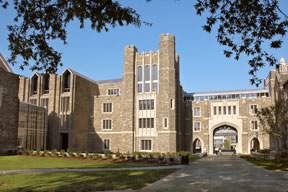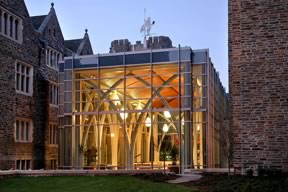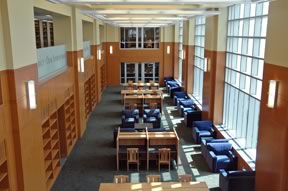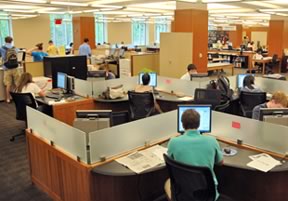Chapter 17. Duke University: Perkins Library
What Is It?
In 2003, Duke University broke ground on a multimillion dollar expansion and renovation of the William R. Perkins Library, the university's largest and most centrally located library. The existing Perkins Library, constructed in three phases between 1928 and 1968, had interior spaces that were dim, musty, claustrophobic, and utterly unsuited to the changing nature of intellectual work in the electronic age. Unaltered for nearly 40 years, Perkins had inadequate infrastructure, outdated mechanical systems, ineffective use of space, inferior study spaces, stacks filled beyond capacity, confusing layout, and poorly coordinated service areas.1 Yet, the existing library, situated adjacent to Duke Chapel at the heart of the university's main campus, represented the only centralized location where new and emerging technologies might be combined with traditional resources to provide a service-rich and uniquely social environment for learning and research. The renovated and expanded Perkins Library, a space not unlike the ancient marketplace or agora, serves students and faculty as an inviting "third place." Neither a formal workplace (scheduled classroom) nor a private realm (dormitory or apartment), the Perkins has become a center for student life as well as intellectual hub and laboratory for learning. (See Figure 1.)
Figure 1. Perkins Library, Exterior View

Planning for the reinvigorated Perkins Library began in 2000. The project reached a significant milestone in October 2005 with the opening of two new facilities. The five-story Bostock Library, linked to the original Perkins Library on four floors, and the von der Heyden Pavilion café (see Figure 2), a graceful solarium-like extension designed for informal study, collaboration, and special events, were designed to echo the Collegiate Gothic architecture that distinguishes the main campus of Duke University. Both buildings, along with the soon-to-be-completed Perkins Tower, add a total of 122,275 square feet to the university's main library, translating into 72,996 linear feet of shelving for the library's collection, open seating for 517 people, 96 computer workstations, 87 individual carrels, 9 group study rooms, and 7 reading rooms.
Figure 2. The von der Heyden Pavilion at Night

The Perkins Renovation Project is far more than an expansion of the library's space—it signals a complete reconsideration of the academic library as a physical place and a qualitative experience. The older Perkins reflected a traditional concept of the library as gatekeeper. Its interior spaces were devoted primarily to the processing, preservation, and security of printed collections, and its layout was confusing for all but the most dedicated of scholars. By contrast, the renovated Perkins embodies a 21st-century vision of the library as gateway and commons, a gathering place for learners rather than a warehouse for books.
After consulting with constituencies across campus, the Perkins Library Renovation Committee worked with an architectural firm2 to design a library for the future, one where public services supporting the entire spectrum of scholarly activity, from idea formation to knowledge production, were brought together at the physical center of an expanded library complex and made absolutely transparent to library patrons. The redesigned first floor of the Perkins Library facilitates this kind of scholarship, making space for a student writing center and a technology support desk. The number of technology-infused group study rooms and project-development spaces has increased substantially to acknowledge that students and faculty have gravitated toward interactive learning and collaboration in the analysis, presentation, and publication of knowledge because of their increasing reliance on electronic databases, digitized formats, and interactive media. While many areas for quiet study remain throughout the library, the sounds of learning are encouraged.
Finally, by embracing the information commons model, Duke librarians understood that they would be moving away from an exclusively location-based notion of service and toward a ubiquitous service concept, one that accepted the full integration of technology into traditional library functions. Duke librarians have taken on an important instructional and consultative role, preparing students who are technologically literate (but not necessarily information literate) to participate in a culture of research governed by general and discipline-specific methods of scholarship, attribution, and dissemination.
What Makes the Space Successful?
Today's students, having grown up in a networked world, arrive on campus with high technology expectations. They regard visual media as their vernacular, multitasking as a way of life, and project-based group work as their preferred mode of learning. They consider technology a vehicle for social interaction that occurs through instant messaging, mobile phones, wikis, blogs, and student-owned laptops. With wireless connectivity and mobile computing, students are moving out from behind their computer monitors to engage with others at any time and anywhere. As a result, the library and all other communal spaces on the traditional campus (corridors, lobbies, adjacencies, gardens, quadrangles) are being rethought. Once augmented with wireless connectivity, whiteboards, and comfortable seating, these public areas take on new purpose and meaning.
The particular value of the Perkins Library as a mixed-use facility rests with its capacity to bring students, faculty, reference librarians, and technology support staff into close proximity with one another, setting the necessary conditions for research-oriented conversation and facilitation. Taking its design cues from the spirit of the modern commercial bookstore and wireless cybercafé, the agile space uses subtle shifts in wall color to distinguish work areas, employs natural light to support mobility and mood, softens harsh right angles with reconfigurable furnishings that offer visual interest and mental stimulation, and provides sheltered spaces within a broader social context for independent or small group work. Comfortable chairs near data ports, electrical outlets, and wireless access points provide refuge for independent study and the opportunity for relaxation. (See Figure 3.)
Figure 3. Comfortable Seating for Study and Relaxation

Functionally and aesthetically, the new Bostock addition to the library complex is a vast improvement over the older Perkins facility. Using extensive input from all sectors of campus, including feedback via LibQual+ and focus groups, planners determined that faculty, students, and staff all wanted large reading rooms, natural lighting, open space design, and the seamless integration of technological services in support of scholarship. (See Figure 4.) The mandate, then, called for inviting spaces equipped with technology and grounded in a robust service program.3
Figure 4. Reading Room with Natural Light

Students flocked to the new Bostock Library from the moment it opened in 2005. Now they can use group study spaces, consult with staff, and produce a final project in their chosen medium and format, all without leaving the library. Duke students, 90 percent of whom own laptops or other portable computing devices, are in the habit of bringing them to the library, with its wireless capabilities, and settling in one of the many comfortable study areas to complete their work. The new Bostock addition (see Figure 5) has increased student library usage by 40 percent between spring semester 2005 and spring semester 2006. Reference desk transactions went up from 809 to 1,115 over that same time period. Revealingly, the number of purely directional questions dropped dramatically, indicating that the library's transparent layout is self-explanatory. Content questions (as opposed to directional inquiries) from undergraduates were up 24 percent, while content questions from faculty and graduate students doubled.
Figure 5. Main Floor of the Bostock Addition

How Is Technology Used?
When it comes to reenvisioning the library to meet the needs of students and scholars in a postdigital age, the importance of strategic partnerships cannot be overstated. At Duke, library administrators worked closely with the university's central technology organization to eliminate any technical barriers that stood in the way of providing seamless, convenient, and easy access to support for the full range of scholarly activities, from idea generation to publication in the appropriate medium and format. The first problem to address involved wireless electronic printing in a new era of portable laptops and mobile computing. Prior to the renovation, the Perkins Library and the central technology organization offered separate e-printing services, a distinction that made little sense to students or faculty. The renovation offered both organizations an opportunity to rethink their relationship and combine forces to build a centrally administered, seamless service tailored to patron needs. As a result, the library now makes use of ePrint, Duke's unified public printing technology, allowing students to print using their laptops, library computers, and IT workstations interchangeably. Students simply download one program/driver, send their print jobs to the central print queue, and retrieve their documents from any ePrint device, regardless of whether that device is in the library, computer lab, or student center.
The unified public printing service deployment quickly became a prototype for the kind of cross-organizational cooperation and integration essential to the success of the information commons model. Together, the library and the central technology organization addressed other issues that required a new culture of sharing across functional boundaries. For example, the library had the goal of adding a substantial number of workstations to extend the quick look-up and database/Internet searching capabilities of traditional library computers by adding productivity software, several Web applications, and tools to let users develop their knowledge products. The issue of how best to manage public workstations located in various locations across a highly decentralized campus is challenging for many universities and colleges. The Perkins Library renovation prompted a new culture of sharing and trust between the library and the central IT organization, leading to the development of an efficient management solution that met the library's goal of offering students exemplary service. The central IT organization now deploys a common roster of software applications (or "central image"), ensuring that students find the same applications installed on the new library workstations as on the machines in the public computer labs elsewhere on campus. At the same time, however, the library retains the ability to add software to or cull software from this central image at its discretion. Prompted by the Perkins renovation, the library and the central IT organization have begun to share physical spaces, staff, resources, and ideas, embarking on a partnership that promises to benefit the entire Duke community for years to come.
As a computing experience, the Perkins renovation offers workstations for students and faculty that meet a variety of needs. First, computer kiosks configured for printing with touch-screen capabilities and basic features (browsers, Office reader plugins, Adobe Reader, media players) are located near the library entrance and the elevators on each floor. Representing a mere 10 percent of the available public computers in the renovated library, these kiosks nevertheless continue to serve an important function, enabling library patrons to conduct quick library searches, check e-mail, text message, and send their papers or presentations to their campus network space for storage. The main floors of the library contain a second tier of computers loaded with general-use productivity suites (for example, Microsoft Office suite, Dreamweaver, Adobe Acrobat, EndNote, iTunes, a freeware image editor, Photoshop Elements, some statistical packages, and so forth) and scanners, along with access to Duke's databases and online resources for students and faculty completing research projects and papers. Finally, the library's upper-floor workstations, which contain more specialized applications (language kits/input editors, data-use and analysis packages, higher-end geographic information systems technology and multimedia production tools, and so forth), are located adjacent to library specialists in international studies, area studies, and social science data, increasing the likelihood that students will take advantage of library human resources as they use tools that require more extensive instruction and/or support.
The Bostock Library owes its popularity more than anything else to its abundance of natural light. Students gravitate to the upper floors, where reading rooms offer the warmth of arts and crafts style interiors, soaring ceilings, large windows, and beautiful views of the Duke Chapel. Using LabStats, library personnel concerned that students would steer clear of the lower-level technology spaces because of the lack of natural light have watched as the popularity of these spaces has grown.4 Students flock to the lower-level resources, which include group study rooms with plasma screens and audio capabilities and a classroom where library personnel instruct students in the effective use of information resources and central IT organization staff train students in specific software applications and multimedia technologies. In the next phase of the information commons project, Bostock's lower level and that of the renovated Perkins Library will form a continuous technology concourse offering a broad range of classroom spaces and technology production rooms along with an array of multimedia and format integration technologies.
What Principles Were Behind the Design?
The redesign of a campus's central library demands that a college or university revisit its most fundamental goals as an institution. How can the library balance its traditional role as an acquirer and preserver of substantial collections with its emerging role as a user-centered, service-rich space for research, collaboration, and creativity and remain agile enough to respond quickly to the changing work patterns of its patrons? The design principles that underlie the Perkins Library renovation represent a thorough acknowledgment of the ways in which technology, by freeing up space once used to shelve printed collections and making it available for human interactions, has renewed the importance of the library as a physical space for teaching, learning, and research. This rediscovery of the library as place is accompanied by a redefinition of the librarian as facilitator, helping guide the new undergraduate curriculum while ensuring that Duke's students leave the university with a level of information literacy that equips them for a lifetime of learning and leadership in a postdigital era. Along with a central information commons, the reinvigorated Perkins Library includes project-development rooms and faculty laboratory spaces that can be reconfigured to support experimentation with new learning models and instructional technologies.
Underlying Duke's approach to library renovation is the notion of built pedagogy, which recognizes that the design of a physical space will influence how people behave within those spaces, encouraging some activities while constraining others. Educational architects speak of the way in which university planners inevitably embody their current pedagogical philosophies in the design of physical spaces, imposing directions for how a space should be used. The information commons model rests on the conviction that the library's physical space must be flexible to encourage serendipitous and ad hoc learning activities in keeping with changing study patterns and student desires. The information commons approach—a human-centered design—privileges those structural elements that encourage multiple types of learning practices and styles. For example, we have learned that students use different spaces for different activities. Many prefer a more industrial space (rows of computers) when focusing on a product like a term paper; when studying, they like solitude with natural light; and designated and ad hoc group study rooms are always popular. The overall design should convey a sense of flow and connection between spaces (fluidity); signal the fact that rooms may be used for multiple purposes (versatility); build in a degree of adaptability at the structural level so that the spaces can be redesigned by others in later years (convertibility); prepare for the possibility of expansion or contraction (scalability); and invite users to rearrange the room and its furnishings as they see fit (modifiability). The trick, of course, is to come up with a design that is both responsive to current needs and flexible enough to accommodate unforeseeable changes in technology, usage, and policy.5
What Is Unique or Noteworthy?
When asked to describe what distinguished the planning process at Duke from those undertaken by other campuses with whom he had collaborated, architect Geoffrey Freeman singled out the very deliberate participation of constituencies from across the university and the clarity they achieved regarding the role of the library in Duke's future. Duke acknowledged as much in 2002 when it recognized the planning process with the university's teamwork award, pointing to the manner in which the goals of faculty, students, library staff, senior administrators, and trustees were reconciled to build a common vision of the library's place in a changing world.6
Endnotes
- Perkins Project.
- The architectural firm was Shepley, Bulfinch, Richardson, and Abbott. The committee was chaired by Robert Byrd, associate university librarian and director of the Rare Book, Manuscript, and Special Collections Library.
- For more details, contact author Thomas Wall.
- LabStats is an application from Computer Lab Solutions designed to measure public computer lab use by workstation platform, location, and time of day (http://www.computerlabsolutions.com/). Anecdotal evidence suggests that students are staying for longer periods of time in the renovated library than they did in the older facility. The library plans to track the duration of student visits and introduce this metric into future analyses.
- For a detailed discussion, see Torin Monahan, "Flexible Space & Built Pedagogy: Emerging IT Embodiments."
- For further information regarding the Perkins Renovation and Information Commons planning processes, please contact Robert Byrd, associate university librarian and director of the Rare Book, Manuscript, and Special Collections Library, or Thomas Wall, associate university librarian and director of Public Services. For information regarding the library's tiered approach to computing and collaboration with the central IT organization, contact Ed Gomes, head of Library Systems Support; John Little, senior IT analyst; or Kevin Davis, senior manager of Student Technology Services, Office of Information Technology. For contact information, see the Duke University staff directory at <http://library.duke.edu/about/directory/>.
About the Authors
Marilyn M. Lombardi is senior strategist at Duke University and an EDUCAUSE Learning Initiative (ELI) scholar in residence.
Thomas B. Wall is associate university librarian and director of public services at Duke University.